
The Apiales are an order of flowering plants. The families are those recognized in the APG III system. This is typical of the newer classifications, though there is some slight variation and in particular, the Torriceliaceae may also be divided.

Pittosporaceae is a family of flowering plants that consists of 200–240 species of trees, shrubs, and lianas in 9 genera. Habitats range from tropical to temperate climates of the Afrotropical, Indomalayan, Oceanian, and Australasian realms. The type genus is Pittosporum Banks ex Gaertn.

Cheiranthera is a genus of ten species of flowering plants in the family Pittosporaceae and are all endemic to Australia. The following is a list of species accepted by the Australian Plant Census as at April 2020:
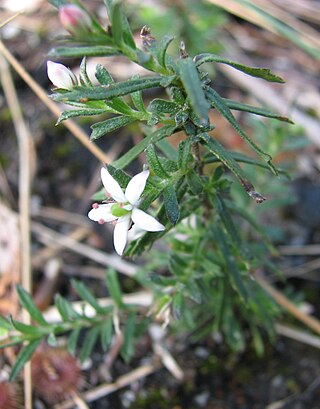
Rhytidosporum is a genus of flowering plants within the family Pittosporaceae. The type species is Rhytidosporum procumbens (Hook.) F.Muell.

Auranticarpa is a genus of trees in the family Pittosporaceae. All six species occur in monsoonal forest and rainforest margins in Northern Australia. The species, all formerly included in the genus Pittosporum, are as follows:
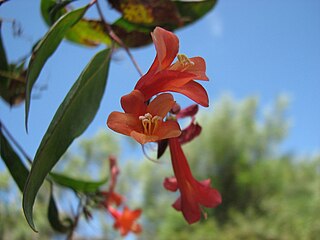
Marianthus is a genus of flowering plants in the family Pittosporaceae and is endemic to Australia. Plants in the genus Marianthus are shrubs with twining branches, simple leaves arranged alternately along the stems. The flowers are pendent, arranged singly or in small groups in upper leaf axils or on the ends of branches with small bracts and bracteoles at the base, but that fall as the flowers open. The sepals are free from each other, and the petals are also sometimes free from each, otherwise joined at the base, forming a tube with spreading lobes. Plants in this genus were previously included in Billardiera, but have a stalked ovary and a long, usually curved style. The fruit is a dehiscent capsule containing many seeds.

Billardiera sericophora is a small spreading shrub in the family Pittosporaceae. The species is endemic to South Australia. Cream to yellow or pale purple flowers appear between August and December in the species' native range. These are followed by cylindrical berries that are about 25 mm long and 8 mm in diameter. The species was formally described by botanist Ferdinand von Mueller in 1852 following its discovery during a botanical survey of Port Lincoln by Carl Wilhelmi.

Marianthus erubescens, commonly known as red billardiera, is a twining shrub or climber of the pittosporum family, Pittosporaceae. The species is endemic to the south-west of Western Australia. It has glossy lanceolate leaves that are 20 to 30 mm long. Red tubular flowers appear in spring and sporadically throughout the year.
Ernst Georg Pritzel was a German botanist.

Billardiera fusiformis, commonly known as Australian bluebell, is a species of flowering plant in the family Pittosporaceae and is endemic to the south-west of Western Australia. It is a sturdy, shrubby climber that has linear to narrowly elliptic leaves and blue, white or pink, nodding flowers arranged singly or in groups of up to four.
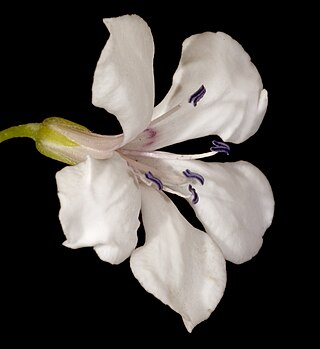
Marianthus candidus, commonly known as white marianthus, is a species of flowering plant in the family Pittosporaceae and is endemic to the south-west of Western Australia. It is a twining shrub or climber with elliptic leaves and white flowers arranged in groups of twenty to thirty and becoming fawn or pink as they age.
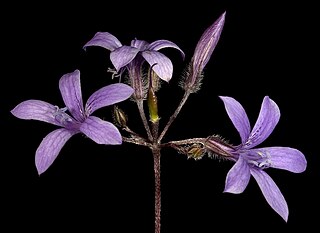
Marianthus drummondianus is a shrub of the pittosporum family, Pittosporaceae native to southwest Western Australia.
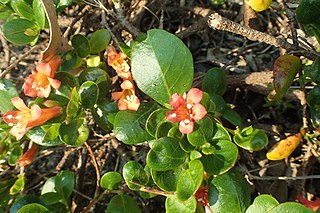
Marianthus paralius is a species of flowering plant in the family Pittosporaceae and is endemic to a restricted part of the southwest of Western Australia. It is a more or less prostrate shrub with thick, egg-shaped leaves and red flowers.
Lindy Webster Cayzer CF is an Australian botanist.
Rhytidosporum inconspicuum is an inconspicuous, rhizomatous shrub in the pittosporum family, Pittosporaceae. The species is found in New South Wales, Victoria and Tasmania.

Billardiera floribunda, commonly known as white-flowered billardiera, is a species of flowering plant in the family Pittosporaceae and is endemic to the south-west of Western Australia. It is a robust twining shrub or climber that has thick, leathery, elliptic leaves and white or pinkish flowers arranged in groups of ten or more.
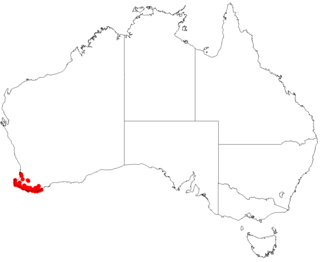
Billardiera laxiflora is a species of flowering plant in the family Pittosporaceae and is endemic to the far south-west of Western Australia. It is a delicate, twining shrub or climber that has linear leaves and white flowers tinged or spotted with pink or mauve.
Marianthus aquilonaris is a species of flowering plant in the family Pittosporaceae and is endemic to a restricted part of the southwest of Western Australia. It is an erect, multi-stemmed shrub with elliptic to oblong leaves and pale blue to almost white flowers arranged singly in leaf axils.

Marianthus bicolor, commonly known as painted marianthus, is a species of flowering plant in the family Pittosporaceae and is endemic to the southwest of Western Australia. It is a low, erect, spreading shrub or climber with narrowly elliptic leaves and white to cream-coloured flowers with maroon or purple striations flowers arranged in branched clusters.














